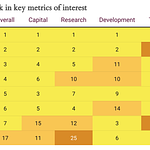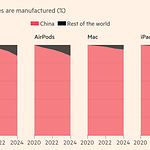Antariksh Matters #1: Can India and the US Head into Space Together?
— Aditya Ramanathan
India and the United States have taken a modest leap towards greater cooperation in space.
Last week, the two countries’ national security advisers, Ajit Doval and Jake Sullivan, kicked off the first meeting of the initiative on Critical and Emerging Technology or iCET. First set up in 2022, the focus of iCET was to enhance technological cooperation in defence as well as other sectors. A fact sheet released after the meeting outlined new avenues of India-US cooperation in defence technology, semiconductor supply chains, 5G, and space.
We’ll be providing our take on some aspects of the iCET soon, but in this Technopolitik entry, I’ll focus on the bits about space.
Three steps outlined in the factsheet stand out. One, the two sides have agreed to train an Indian at the NASA Johnson Space Center, the main facility for training American astronauts. Two, both countries have also agreed to figure out how Indian companies can participate in NASA’s Commercial Lunar Payload Services (CLPS) programme. Three, the factsheet outlines initiatives to increase commercial space cooperation and interaction between academics and experts.
Let’s start with human spaceflight. On India’s Independence Day in 2018, Prime Minister Narendra Modi announced that the Indians would be launched into space on an indigenous mission in 2022 named Gaganyaan. That ambitious plan fell behind schedule, largely thanks to the COVID-19 pandemic. At present, the first Indians are not scheduled to go into orbit only in the last quarter of 2024. Two uncrewed launches will precede the mission to send Indians into orbit to test various parameters of the human-rated spacecraft..
Starting in 2020, four Indian Air Force (IAF) officers also began training at Russia’s Yuri Gagarin Cosmonaut Training Centre for the Gaganyaan mission. While their training was spectacularly ill-timed - starting right at the onset of the pandemic - they nevertheless completed the course in a year. However, with Russia’s space programme financially constrained and heavily sanctioned because of the country’s ongoing war with Ukraine, India is clearly looking to diversify. While the agreement to train Indian spacefarers in the United States may have come too late to speed up the schedule for the first Gaganyaan launch, it is an important step in India’s hunt for a reliable partner to train its ‘vyomanauts’ as ISRO has called them.
India and the US have also inched closer towards cooperating on lunar exploration. The fact sheet commits ISRO and NASA to bring together Indian private sector space companies and American companies involved in the CLPS programme. CLPS is part of America’s expansive plans to return to the Moon sustainably. While NASA is to focus on some of the big-ticket projects like sending humans to the lunar surface, CLPS allows private companies to take scientific payloads from NASA and others to the Moon on uncrewed spacecraft. NASA’s goal is to act as a primary customer for these private missions until they become commercially viable and self-sustaining.
By engaging India with CLPS, the US appears to have two goals. One is to find Indian customers for the American CLPS companies. The other is to involve India in the US-led multinational effort to return to the Moon. Much of this comes under the rubric of what the US calls the Artemis programme. Countries that want to join the Artemis programme are required to sign the Artemis Accords, a series of ten principles governing lunar activity. While most of these principles are innocuous aspects of existing international law, a few, like those that allow the use of lunar resources and call for ‘deconfliction,’ raise concerns about the creation of de facto private real estate or even de facto sovereign territory on the Moon.
By last count, 23 states including the US were part of the Artemis Accords. India has not signed up, evidently because it is concerned that the accords create a parallel legal framework that is designed to primarily serve US interests and impinge on India’s own lunar ambitions.
If Indian companies decide to become customers or even partners in the CLPS, it will be interesting to see if they are implicitly or even explicitly expected to agree to some of the Artemis principles.
The third important aspect of space cooperation outlined in the factsheet is a handful of steps to encourage greater commercial space cooperation and interaction between experts on both sides. India’s Department of Space and the US’ Department of Commerce are to lead a new initiative under the existing Civil Space Joint Working Group or CSJWG to “foster U.S.-India commercial space engagement and enable growth and partnerships between U.S. and Indian commercial space sectors.” While such initiatives may seem minor, they can help pave the way for Indian and American space companies to forge productive partnerships in a heavily regulated sector.
Finally, the fact sheet also announces steps to make “talent exchanges” easier and increase interaction between ISRO and NASA personnel. While these initiatives don’t address some of the gripes Indian private space companies have with visa rules, they are obviously intended to build trust between the two countries’ national space agencies, which have long looked at each other warily.
Biopolitik: The Promise of Gene Drive
— Saurabh Todi
Gene drives are genetic elements of an organism that are transmitted to progeny at higher than mendelian frequencies (>50%). Gene editing techniques such as CRISPR–Cas9 have made gene drives extremely efficient in laboratory settings and have shown the potential to reduce the prevalence of vector-borne diseases, crop pests, and non-native invasive species. Research in gene drives, especially on mosquitoes, is being carried out by scientists at the University of California, San Diego, Texas A&M University, and Massachusetts Institute of Technology, among others. However, concerns have been raised regarding the potential unintended consequences, especially in terms of the ecological impact of gene-drive systems.
Reducing the incidence of vector-borne diseases has become a technology demonstrator for gene drive technology. Mosquitoes engineered with gene drive systems can pass specific genes to the next generation at higher than Mendelian inheritance rates (>50%). This ensures that the target gene spreads through the wild-type mosquito population, despite some associated fitness costs. Gene-drive mosquito techniques work in two major ways: They reduce the population of mosquitos (population suppression); or modify (population replacement) a given vector population.
Population suppression involves the release of modified male mosquitoes to suppress vector populations to a level which makes it difficult to sustain malaria transmission. Population suppression strategies are based on the inactivation, or knock-out, of genes which aim to reduce fertility or production of female progeny or are biased towards higher production of male progeny (which do not bite). In a small study, gene drive mosquitoes wiped out captive populations of mosquitoes in just eight to twelve generations. In contrast, the population replacement method aims to reduce the ability of a mosquito to transmit the malaria pathogen. Population replacement strategies are based on the inactivation of genes that enable mosquitoes to be effective vectors. For example, many potential effector genes have been identified to impair the development of Plasmodium parasites (that cause malaria) by Anopheles mosquitoes (the vector).
The use of either population replacement or population suppression would depend on their relative strengths and challenges in the given situation. For example, population replacement can provide a level of environmental safety because it would not result in the elimination of an ecological niche that an opportunistic invasive species could occupy. However, it is a risky approach because the genetic modification will remain in the environment forever, increasing the likelihood of unintended consequences. To address these concerns, scientists are working on ways to reduce the risk of the unintentional spread of a gene drive mosquito and to ensure researchers hold much more control over their safe manipulation. Scientists at the University of California, San Diego, may have found a way to reduce this risk. They have created a flexible genetic "hacking" system for converting split gene drives (sDGs) into full gene drives (fGDs) while reducing the risk of using the latter.
Although gene drive technology to eliminate vector-borne diseases such as Malaria hasn't been commercialised yet, it holds promise to reduce the scourge of this disease, which causes upwards of 600,000 deaths annually, predominantly in Africa.
Antariksh Matters #2: Reducing Space Threats, Round 3
— Pranav R Satyanath
In the previous edition of Technopolitiik, we covered the recommendations from our discussion document for our OEWG. On a positive note, that version of the document was published as a working paper for the OEWG. But not all was positive in the third round, as we shall see.
Disagreements among states must not shock us. It is exactly what was expected of the group. It seems, however, that the OEWG is widening the divide between some member-states rather than bridging them. More prevailingly, the third meeting of the OEWG also revealed that states do not agree on the working procedures of the group, something that could eventually threaten to derail the entire OEWG process. I identified two issues that could cause deadlocks in the final round of the OEWG, which will be held in August this year.
1. Consensus about consensus: The first major issue that occupied the minds of the member-states was regarding the procedure of the OEWG. The issue of consensus arose when Russia and China protested the participation of non-governmental organisations (NGOs) during the formal session of the OEWG. They argued that since members disagree on the status of NGOs, no consensus can be reached; therefore, agreeing on the participation of NGOs is invalid. The Chair, on his part, ruled the participation of NGOs in the formal sessions as valid since no consensus could be reached.
Russia, China and other states interpreted the Chair’s move as divergence from the OEWG’s mandate and, therefore, an abuse of the Chair’s power. Russia protected the participation of NGOs into the second day, arguing that the lack of consensus about consensus threatens the future of OEWG, including the adoption of a final outcome paper.
2. International Humanitarian Law: The status of International Humanitarian Law (IHL) was already a contested issue in the opening meeting of the OEWG. The contest over the status of IHL grew all the more intense in the third round. China, for its part, argued that invoking IHL would mean accepting outer space as a domain of armed conflict since IHL deals with customary laws of armed conflict. Therefore, applying IHL would mean that states automatically classify outer space as a domain for warfighting. Russia echoed these sentiments while also arguing that Article IV of the Outer Space Treaty (OST) already enables the partial demilitarisation of space. Accepting the applicability of IHL in space, in Russia’s logic, would overturn the principles of the OST.
Of course, the issue of the need for pure legally-binding instruments and the status of non-legally-binding measures persist between states. These matters might sound mundane to many, including veterans of the space sector. However, it is important to note that with no common principles for governing space, we may end up in a situation where no advancements are made to govern the use of dual-use technologies or the deployment of space-based conventional armaments.
Resolving the debates about the founding principles of outer space security, safety, and sustainability is essential to achieve stable, universally-applicable treaties.
Our Reading Menu
[Twitter Thread] Why does chatGPT make up fake academic papers? by David Smerdon
[Report] Controlling the innovation chain: China’s strategy to become a science & technology superpower
[Paper] Digital Power China













The Tech Quest to Eradicate Threats